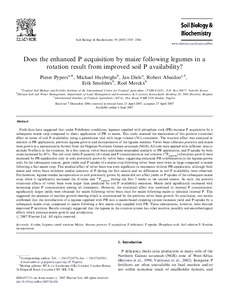| dc.contributor.author | Pypers, Pieter |
| dc.contributor.author | Huybrighs, M. |
| dc.contributor.author | Diels, J. |
| dc.contributor.author | Abaidoo, R.C. |
| dc.contributor.author | Smolders, E. |
| dc.contributor.author | Merckx, R. |
| dc.date.accessioned | 2019-12-04T11:14:15Z |
| dc.date.available | 2019-12-04T11:14:15Z |
| dc.date.issued | 2007-10 |
| dc.identifier.citation | Pypers, P., Huybrighs, M., Diels, J., Abaidoo, R., Smolders, E. & Merckx, R. (2007). Does the enhanced P acquisition by maize following legumes in a rotation result from improved soil P availability?. Soil Biology and Biochemistry, 39(10), 2555-2566. |
| dc.identifier.issn | 0038-0717 |
| dc.identifier.uri | https://hdl.handle.net/20.500.12478/2702 |
| dc.description.abstract | Field data have suggested that under P-deficient conditions, legumes supplied with phosphate rock (PR) increase P acquisition by a subsequent maize crop compared to direct application of PR to maize. This study assessed the mechanism of this positive rotational effect in terms of soil P availability using a greenhouse trial with large volume (74 l) containers. The rotation effect was analysed in relation to PR application, previous legume growth and incorporation of the legume residues. Velvet bean (Mucuna pruriens) and maize were grown in a representative Acrisol from the Nigerian Northern Guinea savannah (NGS). All soils were applied with sufficient urea to exclude N-effects in the rotations. In a first season, velvet bean and maize responded similarly to PR application, and P uptake by both crops increased by 45%. The soil total labile P quantity (E-value) and P concentration in soil solution after plant growth were increased by PR-application only in soils previously grown by velvet bean, suggesting enhanced PR solubilisation in the legume-grown soils. In the subsequent season, grain yields and P uptake of a maize crop following velvet bean were twice as large compared to maize following a first maize crop. This residual effect of velvet bean was even significant in treatments without PR-application, although both maize and velvet bean withdrew similar amounts of P during the first season and no differences in soil P availability were observed. Furthermore, legume residue incorporation in soils previously grown by maize did not affect yields or P uptake of the subsequent maize crop, while it significantly increased the E-value and during the first 7 weeks in the second season. As such, the positive rotational effects of velvet bean were larger than predicted by soil P availability measures. Maize yield significantly increased with increasing plant P concentration among all treatments. However, the rotational effect was unrelated to internal P concentration: significantly larger yields were obtained for maize following velvet bean than for maize following maize at identical internal P. This suggested the presence of another growth-limiting which is counteracted by the previous velvet bean growth. In conclusion, our results confirmed that the introduction of a legume supplied with PR into a maize-based cropping system increases yield and P-uptake by a subsequent maize crop, compared to maize following a first maize crop supplied with PR. These stimulations, however, went beyond improved P nutrition. Results strongly suggested that the legume in the rotation system has other positive, possibly soil-microbiological effects which enhance maize growth and production. |
| dc.description.sponsorship | Directorate-General for Development Cooperation and Humanitarian Aid, Belgium |
| dc.format.extent | 2555-2566 |
| dc.language.iso | en |
| dc.subject | Legume |
| dc.subject | Cereal Crops |
| dc.subject | Crop Rotation |
| dc.subject | Maize |
| dc.subject | Mucuna Pruriens |
| dc.subject | Soil Solution |
| dc.title | Does the enhanced P acquisition by maize following legumes in a rotation result from improved soil P availability? |
| dc.type | Journal Article |
| dc.description.version | Peer Review |
| cg.contributor.affiliation | International Center for Tropical Agriculture |
| cg.contributor.affiliation | Katholieke Universiteit Leuven |
| cg.contributor.affiliation | International Institute of Tropical Agriculture |
| cg.coverage.region | Africa |
| cg.coverage.region | West Africa |
| cg.coverage.country | Nigeria |
| cg.isijournal | ISI Journal |
| cg.authorship.types | CGIAR and advanced research institute |
| cg.iitasubject | Grain Legumes |
| cg.iitasubject | Maize |
| cg.journal | Soil Biology and Biochemistry |
| cg.howpublished | Formally Published |
| cg.accessibilitystatus | Limited Access |
| local.dspaceid | 93630 |
| cg.targetaudience | Scientists |

